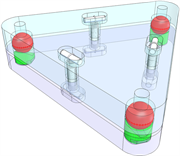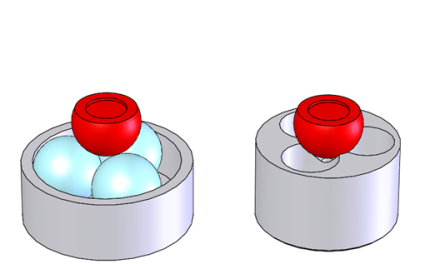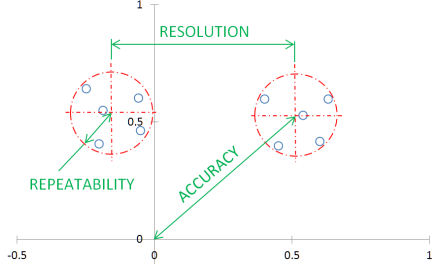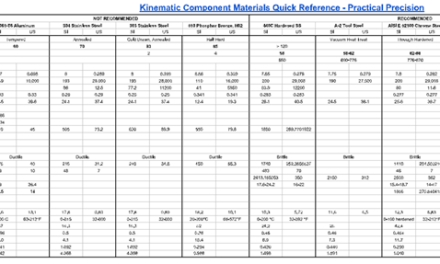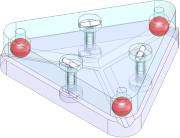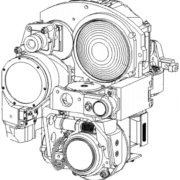Precision engineering is the discipline of designing a machine or instrument so it can maintain, measure, or move to a position or follow a path with a level of accuracy that is many orders of magnitude smaller than the size of the machine or instrument itself.
Precision engineering is also the body of knowledge, wisdom, and techniques used to design such a machine or instrument.
Subdisciplines of precision engineering include precision machine design and optomechanical engineering:
- Precision machine design is typically concerned with using energy to produce a useful action or output with great precision, such as machining a part.
- Optomechanical engineering is typically concerned with holding optical elements in precise locations without distorting their optical surfaces. Motion can be involved either as an active function – such as in an optical zoom mechanism – or as passive compensation – such as in a lens that uses materials with different coefficients of thermal expansion to compensate for changes in focus with temperature (a form of athermalization).
Learn the principles, techniques, and challengesof designing a machine or instrumentwith submicron accuracy
Precision Engineering: Purpose and Performance
As described in Stiffness and Strength: Materials for Precision Machine Design, traditional mechanical engineering is the domain of stress and strength – will a thing break or permanently deform when subject to a given load? How can we optimize the design – in terms of cost, weight, or some other constraint – and still meet this requirement with an adequate factor of safety?
Precision engineering is the domain of deflection and stiffness – will the relative position and orientation of features and components be maintained within acceptable limits when subject to a given load? Will local deformations, such as in the optical surfaces of a lens, affect performance?
Performance of a precision machine or instrument is usually expressed in terms of accuracy of the output while subject to certain constraints, such as throughput, weight, or a harsh operating environment. As discussed in Accuracy, Repeatability, and Resolution of Precision Machines and Instruments, the definition of accuracy depends on the the machine or instrument’s intended purpose, for example:
- A CNC mill – Accuracy is the deviation of machined surfaces from theoretically perfect form
- A coordinate measuring machine – Accuracy is the deviation of measurements of those surfaces from actual form
- A boresighted telescope – Accuracy is the angular deviation of its optical axis from the theoretically perfectly aligned mutual axis.
Performance may also be defined in ways that are a more complex function of the arrangement of and interactions between the machine or instrument’s components, such as the ability to:
- Identify an object of a given size from a distance of 1000 m using an infrared sensor.
- Illuminate that object with a minimum amount of energy from a laser.
- Permanently bond a stack of pre-aligned semiconductor wafers without disturbing that alignment.
For these applications, defining performance, identifying the factors that contribute to it, and expressing the mathematical relationship between them may not be straightforward. But a clear understanding of this is critical to developing a successful solution in a cost- and time-effective way.
Learn the principles, techniques, and challengesof designing a machine or instrumentwith submicron accuracy
The Precision Engineering Toolbox
Precision engineering is also a body of knowledge, wisdom, and techniques that has been developed, tested, and proven over time to be able to achieve these objectives. Examples of these principles and techniques include:
The deterministic principle – Machines and instruments obey cause-and-effect relationships. With enough information about the system and the environment (and enough time and money in the project plan), we can calculate the effects of various loads and effects and compensate for them in the design and operation of the machine. This knowledge can be applied in the form of error models; error budgets; and error mapping and compensation.
Kinematic constraint – Precisely and repeatably locating one rigid body relative to another using no more than six points of contact, without inducing distortion and allowing precision motion in the remaining (6 – N) degrees of freedom.
Counter principles – A theoretically perfectly symmetrical, perfectly formed, perfectly rigid machine has an elegance that one should not aspire to in engineering. All that perfection costs money. Sometimes, the most cost-effective solution is to introduce imperfection. Given the impossibility of achieving a perfectly formed, perfectly rigid machine, it may be better to introduce a small amount of controlled compliance into a system, in such a way that it will relieve stresses while minimally impacting performance.
The Scale of Precision Engineering
It is difficult to quantify what the “precision” in “precision engineering” means. While agreeing on a single definition isn’t critical, the guidelines from a number of experts offer valuable insights into the practice of precision engineering, including the effects that one must be concerned with.
Earlier, I described a precision machine or instrument as having a level of accuracy “many orders of magnitude smaller than the size of the machine or instrument itself.”
Mark Sullivan[1] offers two definitions of the scale, one absolute and one relative. Precision machine design involves:
- “Positioning and stability to very small dimensions, typically below 1 µm.”
- A ratio of the smallest change or uncertainty in the position or stability of one of a machine’s components to the overall dimension of the machine on the order of 10-6.
In The Handbook of Optomechanical Engineering, Daniel Vukobratovich defines:
A stiff structure is one with, “A self-weight deflection that is less than the alignment tolerance.” [2]
This concern with self-weight deflection suggests an axiom:
When effects you would normally ignore are significant,you are operating in the realm of precision engineering.
Some of these effects include:
- Self-weight deflection
- Differential thermal expansion, and
- The storage of energy in the form of strain, which can be released and cause alignment errors under the action of shock, vibration, or temperature variation
At Practical Precision, we will explore these and other effects as well as how to eliminate, mitigate, or compensate for them in training courses and comprehensive articles like this one.
Learn the principles, techniques, and challengesof designing a machine or instrumentwith submicron accuracy
Economics and Precision Engineering at Larger Scales
Now that we’ve taken the time to define the precision scale, it’s important to note that the application of precision engineering principles and techniques is not limited to such scales. At Practical Precision, we’ve helped a wide-range of clients in industries that are not traditionally considered precision manufacturing with:
- Tooling and fixturing used in manufacturing (often in conjunction with automation and robotics) to improve throughput and yield.
- Interchangeability of design variations and of replacement parts, in production and in the field, for increased product flexibility, serviceability, and after-market sales and upgrades.
- Lack of access for service and adjustment in harsh and widely varying environments; the same techniques that ensure stability in a precision machine can be used to design a machine that tolerates a wide range of temperatures and other environmental effects over a long life, without maintenance.
My favorite variation of a well-known engineering saying is:
Anyone can design a bridge that won’t fall down.
It takes an engineer to design a bridge that just barely won’t fall down.
This saying is about having the knowledge to not over design a solution. About knowing the choices of materials and construction techniques available, and understanding the tradeoffs and effects of those choices. It’s about economics.
Whether or not a problem is a precision engineering problem comes down to whether or not the tools and techniques that constitute the practice of precision engineering are an economically advantageous way to achieve the design goals. The financial cost – of development, of production, of support – is a constraint just like accuracy, weight, or stiffness.
Precision engineering itself provides a range of solutions for any given problem such as mount stability, from kinematic mounts to quasi-kinematic mounts to a simple set of three machined pads and reliefs separated by an adequate distance. Which is the appropriate solution depends on the application.
Just as a mechanical engineer working with complex systems benefits from an understanding of electronics and controls engineering (and vice versa), an understanding of the principles of precision engineering and their application can benefit any technician, engineer, or manager involved in the development of complex systems.
Learn the principles, techniques, and challengesof designing a machine or instrumentwith submicron accuracy
precision engineering

